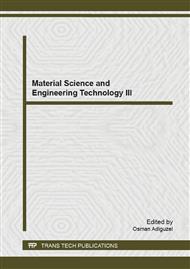[1]
D. Rakwal, E. Bamberg. Journal of materials processing technology. Vol. 209, № 8 (2009). p.3740–3751.
Google Scholar
[2]
F. Dimroth, S. Kurtz. MRS Bull. Vol. 32, № 03 (2007). p.230–235.
Google Scholar
[3]
X. Deng, E.A. Schiff, A. Luque, S. Hegedus. Handbook of photovoltaic science and engineering. A. Luque, John Wiley & Sons, Chichester. (2003). p.359.
Google Scholar
[4]
Claeys, C., & Simoen, E. (Eds. ). Germanium-based technologies: from materials to devices. Oxford, Elsevier (2007). p.19.
Google Scholar
[5]
B. Depuydt, A. Theuwis, I. Romandic. Materials Science in Semiconductor Processing. Vol. 9, № 4–5 (2006). p.437–443.
DOI: 10.1016/j.mssp.2006.08.002
Google Scholar
[6]
T. Taishi, H. Ise, Yu Murao, T. Osawa, M. Suezawa, Y. Tokumoto, Y. Ohno, K. Hoshikawa, I. Yonenaga. Journal of Crystal Growth. Vol. 312, № 19 (2010). p.2783–2787.
DOI: 10.1016/j.jcrysgro.2010.05.045
Google Scholar
[7]
L.I. Khirunenko, V.I. Shakhotsov, V.K. Shinkarenko, F.M. Vorobkalo. Sov. Phys. Semicond. Vol. 24, № 663 (1990). p.344–347.
Google Scholar
[8]
B. Pajot and P. Clauws, in: The Proceedings of the 18th International Conference on the Physics of Semiconductors. Vol. 2. World Scientific Publishing (1987). p.911–914.
Google Scholar
[9]
P. Clauws. Materials science and Engineering. Vol. 36, № 1 (1996). p.213–220.
Google Scholar
[10]
I. Yonenaga, T. Taishi, H. Ise, Yu Murao, K. Inoue, T. Ohsawa, Y. Tokumoto, Y. Ohno, Y. Hashimoto. Physica B. Vol. 407, № 15 (2012). p.2932–2934.
DOI: 10.1016/j.physb.2011.08.038
Google Scholar
[11]
K. Inoue, T. Taishi, Y. Tokumoto, Y. Murao, K. Kutsukake. J. Appl. Phys. Vol. 113, 073501 (2013). p.1–5.
Google Scholar
[12]
B. Pajot, B. Clerjaud in: Optical Absorption of Impurities and Defects in Semiconducting Crystals. Springer Berlin Heidelberg (2013). p.283.
DOI: 10.1007/978-3-642-18018-7
Google Scholar
[13]
O.I. Podkopaev, T.V. Kulakovskaya, A.F. Shimanskiy, A.M. Pogodaev, M.N. Vasilyeva. Journal of Siberian Federal University. Engineering & Technologies. Vol. 5. № 6, (2012). pp.631-637.
Google Scholar


